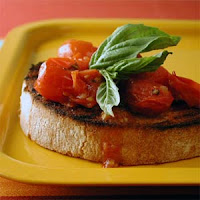In honor of Father's Day on Sunday, I am re-posting my blog on men's health. If you are male or have a male in your life (brother, son, son-in-law, father, father-in-law, grandpa), this will be of interest to you.
This is
National Men’s Health Week, which culminates with Father’s Day on Sunday. The focus of week is to heighten awareness of preventable male health problems and to encourage the early detection and treatment of diseases among men and boys.
Since heart disease, specific cancers, and stroke are the top three leading causes of death among American males, what men may be eating, or unfortunately,
not eating enough of, may be detrimental to their long-term health. "A nutrient-rich diet and a healthy lifestyle are your strongest line of defense against [these] preventable illnesses," says registered dietitian and
Academy of Nutrition and Dietetics spokesperson Jim White.
Parents with young boys please take note: When it comes to making healthy dietary changes to prevent these diseases, the earlier the changes are made, the better.
To celebrate Father's Day, here are some food and diet changes that could provide some disease-fighting, health benefit to all men, no matter what the age. When planning your meal celebration on Sunday, consider putting these foods on the menu. The recipes provided are guaranteed to please all the men around the table.
Heart Disease Fighting Strategies:
One of the American Heart Association’s top diet strategies to beat heart disease is to eat two fish (preferably oily fish) meals (3.5 ounces each) weekly to reduce the risk of heart disease. Fish is not only low in heart-
unhealthy saturated fat but also provides heart-healthy, omega 3 fatty acids. Research shows that these fatty acids may prevent irregular heart-beats, reduce atherosclerosis, and mildly lower blood pressure. Americans are currently consuming only about 0.1 to 0.2 grams of omega 3s daily, on average, as compared to the 0.5 grams recommended a day. Two fish meals a week will not only meet this daily recommendation but also displace saturated-fat laden protein-rich food, such as hot dogs, regular ground beef, and fried chicken on the plate.
Father’s Day Menu Ideas:
 |
| Photo Source: My Recipes |
Skip the grilled steaks this year and try this easy
Grilled Salmon with Tomato Salsa recipe instead as the main course. To squeeze a second fish meal during the week, pack a tuna fish sandwich at lunch. Combine drained, canned tuna with light mayonnaise, chopped celery, and a dash of onion powder and stuff along with lettuce and tomatoes or grilled veggies (see below) into a whole wheat pita for a heart disease-fighting lunch.
Cancer Fighting Strategies:With prostate cancer being the
second leading cause of cancer death among American males, the photochemical, lycopene, may be one of best disease-fighting compounds on the plate. Research suggests that lycopene found in tomatoes and tomato products, may help prevent prostate cancer. Cooking the tomatoes as well as serving them with a tad of oill has also shown to enhance the body’s absorption of this photochemical. Watermelon, pink grapefruit, and guava are other delicious food sources of lycopene.
Father’s Day Menu Ideas: |
| Photo Source: My Recipes |
Serve tomato-rich salsa with wholegrain tortilla chips and or
bruschetta on whole grain bread as an appetizer. Lightly coat tomato halves with olive oil and chopped garlic and grill until lightly seared. Sprinkle with chopped fresh basil for a savory and colorful tomato side dish. Make sure watermelon is on the dessert menu.
Stroke-Fighting Strategies:While limiting the sodium in the diet is important to lower high blood pressure, a risk factor for stroke, eating
more potassium-rich foods such as fruits and vegetables can also lower blood pressure. Unfortunately, many Americans are falling short of the amount of potassium recommended daily as most are not eating the
minimum recommended 4.5 cups of fruits and veggies a day.
Father’s Day Menu Ideas:
 |
| Photo Source: My Recipes |
While you are cooking the salmon on the grill, leave a space for a variety of grilled veggies. Toss together fresh broccoli, red peppers, zucchini, portobello mushrooms, and Vidalia onions with your favorite low-fat Italian dressing and grill to perfection. Make sure there is enough for leftovers to stuff in a pita sandwich for the next day’s lunch. Here’s another fabulous recipe for
Citrus Herb Grilled Vegetables.
Here's to good health for all men, young and old. Follow Joan on Twitter at: joansalgeblake






















